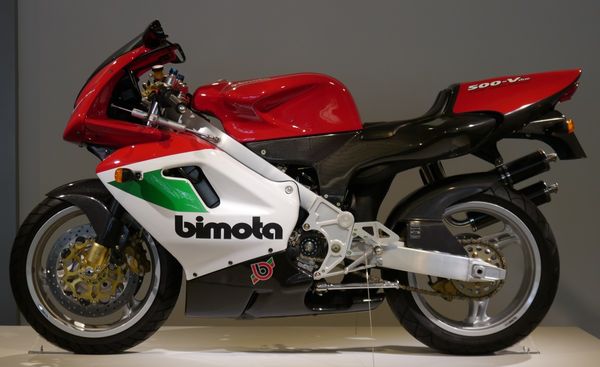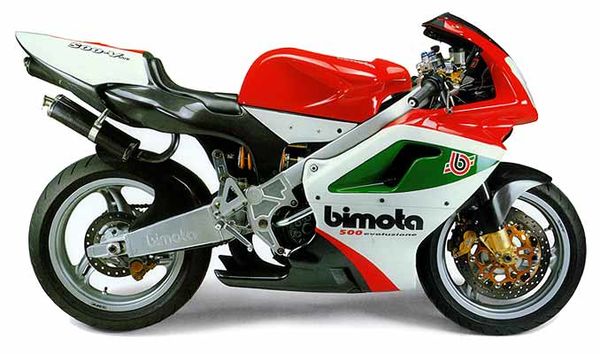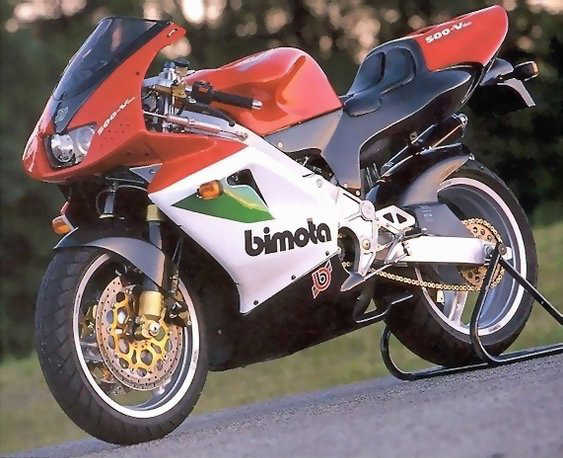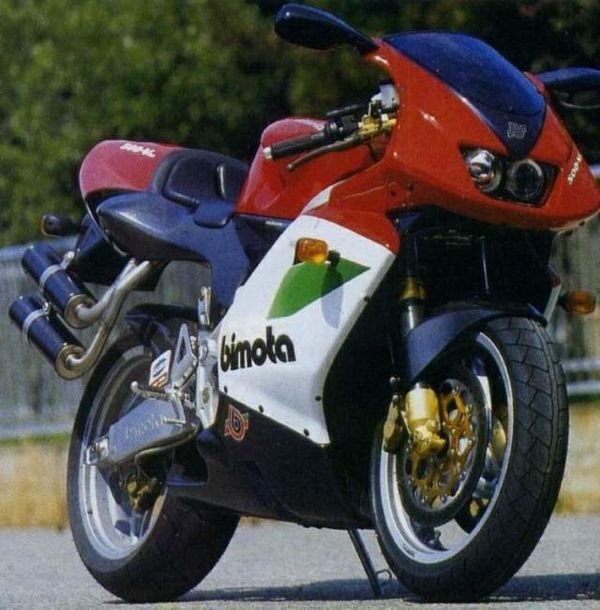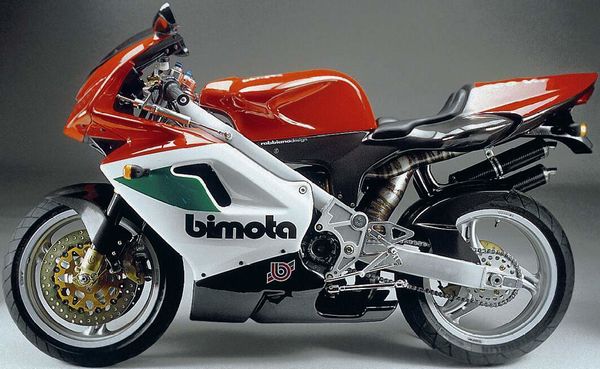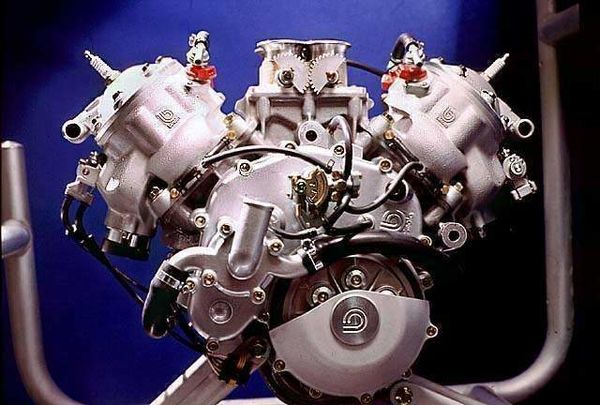Bimota 500 V-Due
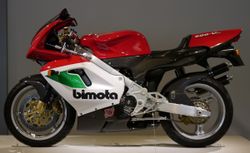 |
|
| Bimota Vdue 500 | |
| Manufacturer | |
|---|---|
| Also called | 500 V-Due |
| Production | 150 units |
| Engine | Two stroke 90°V-twin |
| Compression ratio | 12:1 |
| Top Speed | 265.5 km/h / 165 mph |
| Transmission | 6 Speed |
| Frame | Tubes of oval section, made of light aluminum alloy. |
| Suspension | Front: 46mm Paioli telescopic forks fully adjustable Rear: Monoshock, fully adjustable for preload and damping. |
| Brakes | Front: 2x 320mm discs Rear: Single 230mm disc |
| Front Tire | 120/70 ZR17 |
| Rear Tire | 180/55 ZR17 |
| Seat Height | 820 mm / 32.3 in |
| Weight | 176 kg / 388 lbs (dry), |
| Fuel Capacity | 20 liters / 5.28 gal |
| Manuals | Service Manual |
It could reach a top speed of 265.5 km/h / 165 mph.
Engine[edit | edit source]
The engine was a Liquid cooled cooled Two stroke 90°V-twin. The engine featured a 12:1 compression ratio.
Chassis[edit | edit source]
It came with a 120/70 ZR17 front tire and a 180/55 ZR17 rear tire. Stopping was achieved via 2x 320mm discs in the front and a Single 230mm disc in the rear. The front suspension was a 46mm Paioli telescopic forks fully adjustable while the rear was equipped with a Monoshock, fully adjustable for preload and damping.. The 500 V-Due was fitted with a 20 liters / 5.28 gal fuel tank. The bike weighed just 176 kg / 388 lbs.
Photos[edit | edit source]
Overview[edit | edit source]
Bimota 500 V Due
The V-Due hit the headlines when it appeared in 1997. The pioneering Italian firm had developed a direct-injection two-stroke engine, a holy grail for engine designers. Normal carburetor-equipped two-strokes are polluting and fuel-inefficient: a fuel-injected version would fix both these problems, allowing a light, powerful engine that could pass emissions laws. While the engine was innovative, the chassis was typically Bimota. An oval-tube aluminum frame provides supreme stiffness, while fully adjustable Paioli forks and an Öhlins shock give a supple, well damped ride. The V-Due could have been an amazing machine, with the handling of a 400 and power of a 750, but it was dogged by fuel-injection flaws and discontinued a year later.
The only Bimota ever made that
was actually fitted with a Bimota engine was the V Due. Launched in 1997,
the V Due was fitted with Bimotas own 500cc, liquid-cooled, two-stroke,
fuel-injected v-twin that made 110bhp at 9000rpm, and 90Nm of torque at
8000rpm. Unlike carb-equipped two-strokes, the V Dues radical,
direct-injection two-stroke engine which took eight long years of Bimotas
development time, effort and money was supposed to be low on emissions,
allowing it to meet mandated norms in the US and in Europe.
But fuel-efficiency and emissions compliance wasnt, of course, the V Dues
primary mission in life. The bike, initially meant to be a 500cc GP racer,
was designed to deliver GP-spec performance and handling on the street. And
to go with the 500cc two-stroke engine, the V Due was equipped with a stiff,
lightweight aluminum chassis, meaty aluminum swingarm, six-speed
cassette-type gearbox, 17-inch wheels, fully adjustable 46mm Paioli forks
and Öhlins rear shock, and Brembo brakes. Tyre sizes were 120/70 ZR17 at the
front, and 180/55 ZR17 at the rear.
With its carbonfibre bodywork and exhaust
cans, Bimota claimed a dry weight of less than 150 kilos for the V Due.
According to some late-1990s magazine road tests, the racy little Bimota was
capable of doing the standing quarter-mile (400m) in 12.5 seconds (hitting a
speed of 185km/h in the process), and had a top speed of 265km/h.
Exotic, expensive (about US$30,000 back then ) and desirable it may have been, but ultimately its high-tech engine was the V Dues undoing. With limited resources and manpower, could never fully sort out the bikes very inconsistent fuel-injection system and the erratic power delivery. Soon, customers started demanding that the company take the bikes back and refund their money.
This resulted in Bimota stopping production of the V Due after making only 340 units, instead of the 500 proposed earlier. And it didnt stop at that Bimotas already precarious financial condition spiraled completely out of control after the V Due debacle. And even though the company tried to contain damage by fitting carburetors to some V Dues dubbed the V Due Evoluzione Strada the company went bust in 1999-2000, before it had a chance to sell any of those reengineered bikes.
The story of my Bimota V-Due Bimota always borrowed someone else's engine, put it in their own design and ended up with something special. A few years ago they wanted to build a GP replica bike and decided on something quite spectacular. A GP replica powered by their own 500 cc two stroke fuel injected engine. The result was, on the face of it, purely spectacular. It weighed the same as an Aprilia RS250 but with twice the power and looked the business. The downside was that it didnt work, literally. Owners complained about everything from peaky performance to intermittent power, dodgy electrics, plug fouling, weak cranks etc. The owners demanded a full refund. Bimota obliged and subsequently went bankrupt. The V due engineer (Piero Caronni) for Bimota ended up buying all of the bikes, spares and legal rights and set up on his own. Many bikes were given the full overhaul to fix including binning the direct fuel injection system in place of a set of Dellorto carbs. This worked to a certain extent and can still be bought today. Good results have been obtained with retaining the direct injection system and upgrading the rest of the internals. The injection bikes are of course more in keeping with the original idea from Bimota and carbs were a quick fix with limited success.
Bearing all of the above in mind I am a true
two-stroke nut and wanted one from day one. The downsides are as follows:
You buy it blind from a stranger in Italy who speaks little English. You have to choose from an original bike with no modifications, a carburetor bike or an injection bike with some problems fixed. They cost the earth and they come with no warranty. You cant ride one in your local dealership to see what it rides or fits like. The factory in Italy openly admit the bikes are fraught with problems. They are unreliable and spares are a costly nightmare. On full power they only do 15 miles to the gallon they drink fully synthetic two stroke oil at £15.00 a litre like its going out of fashion. It is subject to 17.5% VAT duty at the point of registration in the UK. It has to be put through the UK SVA test which it may or may not pass and it has to be road registered at DVLA and may go on a P plate as bike made in 1997. The delivery man speaks even less English.
Belly pan cracks after several miles of riding. Engine needs total strip and rebuild by a two- stroke expert prior to ever riding due to set up at factory being very poor, then it needs full rebuilds approximately every 3K miles. It may never arrive. It may never run.
The good points speak for themselves though:
It is a 500CC two stroke that looks the business and weighs very little. If you have always wanted a big two stroke your options are limited. Its either buy a 350 LC and tune it to the max, buy an RGV 250 or Aprilia rs 250 type machine and bore the engine out, buy an RD or RG 500 and ride it as is or update the bike overall or start a 500cc special project like an RGV 500. If you want a modern 500cc two stroke with modern extras, modern handling and looks there is only the V-Due. There are only a handful in the UK and most are track day bikes only. The remaining bikes are unlikely to meet in the same place at the same time- although that would be a sight.
I saw one advertised years ago and I wanted it, but couldnt afford it. I read they were unreliable, owners sent them back and they were bankrupt, I was gutted. I read that someone had bought the rights to them and was selling them off. They were still too expensive though. I bought an RD350 instead and rode it till it blew. I bought an Aprilia RS250 and loved it so much I bought another. I owned everything from a Fireblade to a Ducati 851 to a GSXR 1100... and everything in between. I still wanted a V Due, but couldnt afford one. I looked at building a 500 cc special via BDK racing, who specialize in RGV 250/500 conversions, but built up bikes were circa £6000 plus. I also looked at buying an RG or RD 500 and updating it. But it was too expensive given the poor quality finish and unreliability. So I decided to buy a V Due.
I looked for a V-Due carb version and found the
only one in the country (already road registered) was for sale. Whilst
negotiating around the £10K marker it was sold to someone else. Gutted, I
contacted the factory in Italy directly and swapped lots of emails.
In the end I decided on an injected bike with
electrics, lubrication and crank problems solved. Only issue with the bike is
that it oils up the plugs constantly causing poor jerky running, intermittent
power delivery and plugs need replacing after every trip. Great.
I agreed a price in Euros with factory. Deposit
wired to his account in Italy. Delivered via Belgium in a van to bike dealer in
Norfolk. Euros sent by post to pay the balance. Delivered to me at home a month
later.
Luckily for me I had a very good rapport with an
owner called Paul Clarke from London who steered me in the right direction with
regards to problems encountered.
I put the bike through SVA test in the UK and it passed first time- although it
wasnt running.
It ran like a pig, then overheated , then stopped. So I sent to a man in the know - 2 stroke god Mark Brown from Nottingham, to be adapted to have oil injectors moved to the throttle bodies to run like a normal two stroke. Mark Brown completely sorted the bike from top to bottom. I also had the water cooling system adapted to stop it over heating, changed the ECU units as faulty ones came with bike, swapped the fuel pump as it was gunged up and not working correctly and put 3 different speedos on it until I found one that worked. I've never looked back since... best bike in the world. Hassle factor 10 out of 10, Enjoyment/pose factor 1 million. What a treat!!!
Source MCN
review
In 1996-97, Bimota was set to introduce a new machine that would revolutionize sport bikes. It would be an unstoppable, razor sharp 500cc two-stroke that would give 1000cc four strokes a run for their money, in a time when it appeared that two-strokes were on their way to the bone yard. There was a lot of excitement brewing around the forthcoming V-Due (literally, V-twin) - not only because of the mouth-watering specs and the fact it was being built by one of motor cycling's most legendary boutique marques, but also because it promised to fix the "problem" that two stroke road bikes were facing.
That "problem" was increasingly strict emissions laws. In the 1990s strokers were getting phased out, quickly, due to stricter EU and EPA emissions requirements. They were being relegated to off-road and track use - as either motocross machines or track-only race bikes, with street legal bikes an impossibility in the US and Europe in the face of the new restrictions. Two strokes, by their very design, are nasty polluters. Not only because of the mix of oil and fuel required to lubricate the bottom end, but also by the nature of a two-stroke cycle.
You might want to skip over this next bit if you get bored to death by technical theory.
A two-stroke operates by simplifying the usual four stroke cycle. Four strokes are "suck-squish-bang-blow" - intake charge of air and fuel on down stroke, compression stroke up, ignition and push of piston back down, exhaust stroke up to expel gasses. Valves in the top of the combustion chamber open to let the fuel/air in, close to allow compression and ignition, then open again to let the exhaust gas leave. Repeat. Two strokes have two cycles - suck/blow-squish/bang. The "valves" are open ports in the walls of the cylinder, routed through the crankcase. When the piston goes down, it pulls fuel mix in on one side of the chamber while simultaneously forcing exhaust gas out the other side. When it goes up, the chamber is sealed, compression is made, ignition, piston goes back down. Repeat.
The advantage of strokers is far more power per displacement than a four stroke of equivalent displacement. Sometimes double - a 500cc two stroke is roughly equivalent to a 1000cc four stroke. But in a much lighter and simpler package. Hence why the V-Due was so hotly anticipated - here was a lightweight super sport with top shelf components that could eat bigger sport bikes for breakfast. It was hyped up to be the closest thing to a road legal GP bike since the RG500 and NS400R bowed out in 1987. In fact, it was touted as a legitimate GP bike for the road - the original V-Due was a racing project that was later switched to a road bike program. Power was expected to be 110hp in a bike that weighed just over 300lbs - remarkable numbers for the mid 90s, when a typical super bike was easily 450-500 lbs.
The disadvantage of 'strokers is short service life (frequent bottom end rebuilds) and terrible emissions. Up to this point two strokes used carburetors - a carburetor will flow fuel constantly, even when the throttle is closed, because it delivers fuel based on the vacuum of the intake. The most strictly controlled emissions are usually unburned hydrocarbons (unburned gas) making its way into the exhaust. It's a problem on four strokes as well. Two strokes are especially bad because the exhaust and intake ports are open at the same time - so raw fuel mix will always flow across and get into the exhaust no matter how carefully you tune the engine.
Still awake? Good, back to the Bimota.
Why was the V-Due the only game in town, and why was it so anticipated? Because Bimota claimed they had fixed the emissions issue by developing a fuel injected two-stroke with electronic ignition, something that had never been done in a motorcycle before. Direct fuel injection delivers a jet of gas when needed into the cylinder, and shuts off completely when it isn't - unlike a carburetor. You can time fuel delivery precisely so it won't slip through the combustion chamber and into the exhaust, and the electronic ignition can time the spark to ensure a full burn. The V-Due also used forced lubrication for the bottom end, with only minor oil mixing required to lubricate the pistons. It was topped off with a trick cassette gearbox and dry clutch, racy stuff for a road bike. So, some revolutionary technology and clever engineering and the two-stroke lives to fight another day. All eyes were on Bimota, and some early press reviews praised the handling and power the V-Due was going to offer.
With this kind of hype, disappointment was inevitable. And boy, was the V-Due a disappointment when it hit the market.
The first production models arrived in 1997 and right away major problems became apparent. Yes, they passed emissions testing and the bike was 50 state legal - but the fuel injection system was not at all sorted out, and the bikes were almost completely un-rideable. Throttle response was terrible, the engine hunted badly at steady speeds, and power delivery was extremely violent and only came on at the top of the rev range. While it was light and quick, power wasn't up to snuff among the crop of high powered super bikes that began to emerge in the late 90s. Aside from being despicable to ride it also had electrical faults, a tendency to foul spark plugs, and had some major mechanical faults that led to piston and crank seizures. Oh, did I mention that this half-baked Italian cost about $30 000 (£14500)? Yeah, that definitely did not help the reputation - especially among UK magazines where writers have a penchant for being brutal in their reviews when something doesn't measure up.
It wasn't all bad. While the in-house engine design (built by Moto-Morini) was more or less a turkey, the chassis was brilliant. It looked sexy and had stellar handling, helped by a dry weight right around 320 lbs. Front suspension was courtesy of Paoli, rear by Ohlins. Brembo Goldlines took care of stopping power. Carbon fibre was used liberally. It looked the business and could find its way around a track, even if it didn't run properly. Like many Italian motorcycle fans have said since time immemorial - it's brilliant, when it's working.
It quickly became clear that the V-Due was a liability for Bimota. They began accepting returns and in 1998 they release the Evoluzione upgrade - which ditched the wonky fuel injection for a pair of 39mm Dellorto carburetors. Suddenly the modus operandi of the V-Due (introducing modern FI to two strokes) was ditched in an effort to simply make the thing work. But it was a case of too little, too late. Bimota went bankrupt in 1999, after having produced 340 V-Dues of the proposed 500 example run, 21 of which were the Evoluzione.
But all was not lost. One of the project engineers, Piero Caronni, bought the remaining bikes and spares when the company went into receivership. He subsequently began modifying and fixing the issues, culminating in the Evoluzione 03, Evoluzione 04 and Edizione Finale models - introduced in 2003 and 2004. All used carburetors and modified engines with much improved reliability. Power was up as well, to 120 hp for the 03 and 130hp for the 04 and Finale. These sorted bikes have a strong cult following, with dedicated owners who are quick to dismiss the bad reputation surrounding these machines.
Source
| Make Model | Bimota 500 V Due |
|---|---|
| Year | 1997 - 99 |
| Production | 150 units |
| Other Related | V Due Corsa (1999 - 2001, 26 units) V Due Corsa Evoluzione (2001 - 2003, 120 units) V Due Evoluzione (2003, 14 units) V Due Edizione Finale ( 2005, 30 units) |
| Engine Type | Two stroke 90°V-twin |
| Displacement | 499 cc / 30.45 cub in |
| Bore X Stroke | 72 x 61.25 mm |
| Compression | 12:1 |
| Cooling System | Liquid cooled |
| Induction | Twin injectors |
| Starting | Electric |
| Max Power | 76.6 kW / 105 hp @ 9000 rpm |
| Max Torque | 90 Nm / 9.2 kgf-m/ 66.4 lb-ft @ 8000 rpm |
| Transmission | 6 Speed |
| Final Drive | Chain |
| Frame | Tubes of oval section, made of light aluminum alloy. |
| Front Suspension | 46mm Paioli telescopic forks fully adjustable |
| Rear Suspension | Monoshock, fully adjustable for preload and damping. |
| Front Brakes | 2x 320mm discs |
| Rear Brakes | Single 230mm disc |
| Front Tire | 120/70 ZR17 |
| Rear Tire | 180/55 ZR17 |
| Weelbase | 1340 mm / 52.8 in |
| Seat Height | 820 mm / 32.3 in |
| Dry Weight | 176 kg / 388 lbs |
| Fuel Capacity | 20 liters / 5.28 gal |
| Consumption Average | 9.05 l/100km / 26 mpg |
| Braking 60 - 0 / 100 - 0 | |
| Standing ¼ Mile | 12.5 sec / 185.9 km/h / 115.5 mp/h |
| Top Speed | 265.5 km/h / 165 mph |
| Review | Performance Bike |
